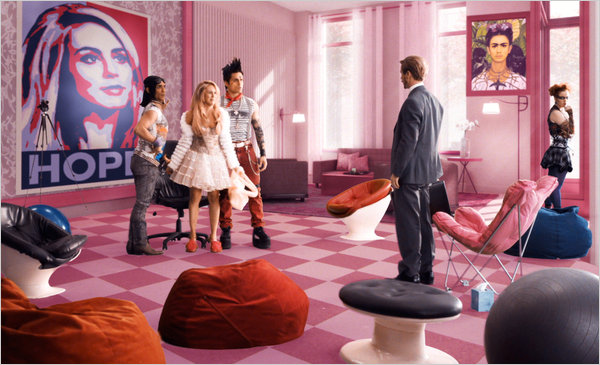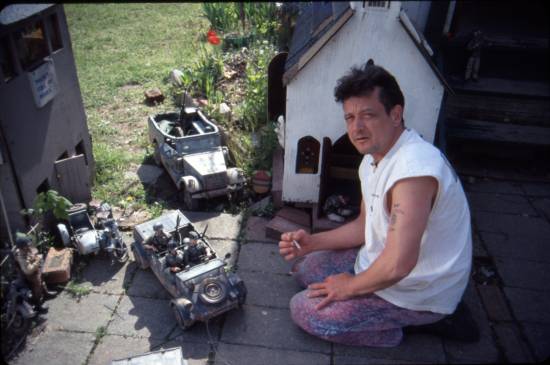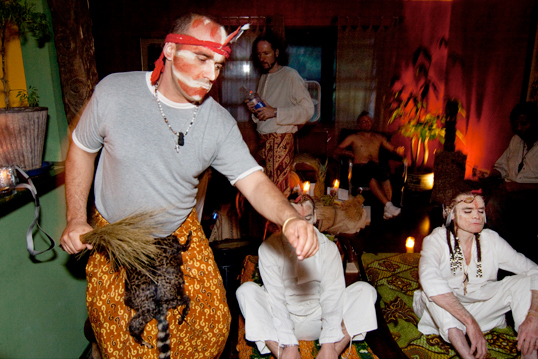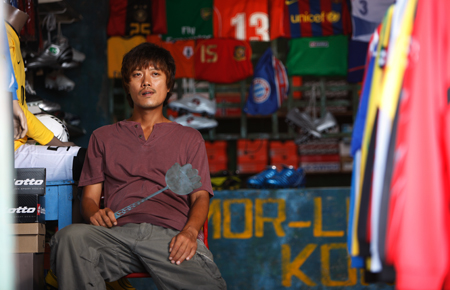REPO CHICK (Alex Cox, 2009)
IFC Center
323 Sixth Ave. at Third St.
January 14-20, 1:35, 7:55, 10:00
212-924-7771
www.ifccenter.com
 Cult director Alex Cox, the mastermind behind REPO MAN and SID & NANCY, must have threatened the people running the 2009 Venice Film Festival with a barrage of Growler missiles to get this unwatchable, thoroughly embarrassing piece of pernicious nonsense to be included in the prestigious festival’s competition. This very strange, low-rent satire, made primarily on green screen, is an unbelievably lame supposedly comic thriller about Pixxi De La Chasse (Jaclyn Jonet), a disinherited debutante who gets a job working for a pair of repo men (Miguel Sandoval and Robert Beltran) after her father (Xander Berkeley) and aunt (Karen Black) cut her off because of her penchant for getting arrested. Upon learning of a million-dollar reward for repossessing a long-missing train, Pixxi is determined to prove to her family, her Euro-trash wannabe sidekicks (Danny Arroyo as 666, Jennifer Balgobin as Nevavda, and Zahn McClarnon as Savage Dave), and fellow repo woman and urban legend expert Lola (a nearly unrecognizable Rosanna Arquette) that she can take care of herself, even as terrorists threaten to blow up Los Angeles with Cold War-era Growler missiles if the game of golf isn’t banned. Or something like that. While it’s possible that Cox might have been striving to make one of those so-bad-it’s-good kind of movies, he’s failed at that as well, even dragging Chloe Webb into this disaster. REPO CHICK is in no way a sequel to REPO MAN, but it does bring down its legend ever so slightly, especially when it includes the word “pernicious” in the dialogue, a direct link to the great “pernicious nonsense” line delivered in its awesome predecessor. The lone saving grace is activist singer-songwriter Danbert Nobacon’s “Jamestown 2007” song that plays over the end credits, but you’re better off just checking that out on his record THE LIBRARY BOOK OF THE WORLD. (Nobacon makes a cameo in the film, while Cox illustrated the former Chumbawumba leader’s 2010 book THREE DEAD PRINCES.) REPO CHICK will screen at the IFC Center for one week before being released on Blu-ray and DVD February 8.
Cult director Alex Cox, the mastermind behind REPO MAN and SID & NANCY, must have threatened the people running the 2009 Venice Film Festival with a barrage of Growler missiles to get this unwatchable, thoroughly embarrassing piece of pernicious nonsense to be included in the prestigious festival’s competition. This very strange, low-rent satire, made primarily on green screen, is an unbelievably lame supposedly comic thriller about Pixxi De La Chasse (Jaclyn Jonet), a disinherited debutante who gets a job working for a pair of repo men (Miguel Sandoval and Robert Beltran) after her father (Xander Berkeley) and aunt (Karen Black) cut her off because of her penchant for getting arrested. Upon learning of a million-dollar reward for repossessing a long-missing train, Pixxi is determined to prove to her family, her Euro-trash wannabe sidekicks (Danny Arroyo as 666, Jennifer Balgobin as Nevavda, and Zahn McClarnon as Savage Dave), and fellow repo woman and urban legend expert Lola (a nearly unrecognizable Rosanna Arquette) that she can take care of herself, even as terrorists threaten to blow up Los Angeles with Cold War-era Growler missiles if the game of golf isn’t banned. Or something like that. While it’s possible that Cox might have been striving to make one of those so-bad-it’s-good kind of movies, he’s failed at that as well, even dragging Chloe Webb into this disaster. REPO CHICK is in no way a sequel to REPO MAN, but it does bring down its legend ever so slightly, especially when it includes the word “pernicious” in the dialogue, a direct link to the great “pernicious nonsense” line delivered in its awesome predecessor. The lone saving grace is activist singer-songwriter Danbert Nobacon’s “Jamestown 2007” song that plays over the end credits, but you’re better off just checking that out on his record THE LIBRARY BOOK OF THE WORLD. (Nobacon makes a cameo in the film, while Cox illustrated the former Chumbawumba leader’s 2010 book THREE DEAD PRINCES.) REPO CHICK will screen at the IFC Center for one week before being released on Blu-ray and DVD February 8.


 Named Best Documentary at numerous film festivals across the country, MARWENCOL offers a surprising look inside the creative process and the fine line that exists between art and reality. On April 8, 2000, Mark Hogancamp was nearly beaten to death outside a bar in his hometown of Kingston, New York. He spent nine days in a coma and more than a month in the hospital before being released, suffering severe brain damage that has left his memory a blur. To help put his life back together, he began using toys and dolls — Barbies, celebrity replicas, army men — to re-create his personal journey. He makes dolls of his friends and relatives, the people he works with, and others, constructing an alternate WWII-era universe he calls Marwencol, complete with numerous buildings and plenty of Nazis. He captures the detailed story in photographs that are not only fascinating to look at but that also help him figure out who he was and who he can be. This miniature three-dimensional world is reminiscent of the two-dimensional one carefully fashioned by outsider artist Henry Darger in his fifteen-thousand-page manuscript, The Story of the Vivian Girls, in What is known as the Realms of the Unreal, of the Glandeco-Angelinnian War Storm, Caused by the Child Slave Rebellion, which also features an alternate reality involving military battles set amid stunning artwork. Director, producer, and editor Jeff Malmberg makes no judgments about Hogancamp, and asks the same of the audience. In his first full-length film, Malmberg shares the compelling story of a deeply troubled, flawed man suddenly forced to begin again, using art and creativity to bring himself back to life. He speaks with Hogancamp’s mother, his old roommate, the prosecutor who handled his case, and others who are first seen proudly holding the doll Hogancamp made of them. And Malmberg doesn’t turn away from the more frightening aspects of Hogancamp’s daily existence. MARWENCOL is an unforgettable portrait of lost identity and the long road to redemption.
Named Best Documentary at numerous film festivals across the country, MARWENCOL offers a surprising look inside the creative process and the fine line that exists between art and reality. On April 8, 2000, Mark Hogancamp was nearly beaten to death outside a bar in his hometown of Kingston, New York. He spent nine days in a coma and more than a month in the hospital before being released, suffering severe brain damage that has left his memory a blur. To help put his life back together, he began using toys and dolls — Barbies, celebrity replicas, army men — to re-create his personal journey. He makes dolls of his friends and relatives, the people he works with, and others, constructing an alternate WWII-era universe he calls Marwencol, complete with numerous buildings and plenty of Nazis. He captures the detailed story in photographs that are not only fascinating to look at but that also help him figure out who he was and who he can be. This miniature three-dimensional world is reminiscent of the two-dimensional one carefully fashioned by outsider artist Henry Darger in his fifteen-thousand-page manuscript, The Story of the Vivian Girls, in What is known as the Realms of the Unreal, of the Glandeco-Angelinnian War Storm, Caused by the Child Slave Rebellion, which also features an alternate reality involving military battles set amid stunning artwork. Director, producer, and editor Jeff Malmberg makes no judgments about Hogancamp, and asks the same of the audience. In his first full-length film, Malmberg shares the compelling story of a deeply troubled, flawed man suddenly forced to begin again, using art and creativity to bring himself back to life. He speaks with Hogancamp’s mother, his old roommate, the prosecutor who handled his case, and others who are first seen proudly holding the doll Hogancamp made of them. And Malmberg doesn’t turn away from the more frightening aspects of Hogancamp’s daily existence. MARWENCOL is an unforgettable portrait of lost identity and the long road to redemption.
 Declaring this to be “the Plastic Age,” Viennese filmmaker Werner Boote travels the globe in PLASTIC PLANET, seeking answers that are not very easy to come by about the mysterious material. Boote grew up around the plastics boom, his grandfather an early manufacturer of the non-biodegradable synthetic. Boote meets with former president of PlasticsEurope John Taylor, Italian judge and politician Felice Casson, environmental scientist Susan Jobling-Eastwood, Japanese artist Hiroshi Sagae, American biophysicist Scott Belcher, Austrian environmental analyst Kurt Scheidl, European Commission vice president Margot Wallstrom, German plasticization specialist Gunther von Hagens, and others, each of whom has a different relationship with plastic, some citing its many virtues, others emphasizing its myriad dangers. Perhaps the most important thing Boote discovers is the power of the plastics industry in maintaining secrecy over the exact chemicals that go into their products, claiming that the release of such information could ruin their businesses. Thus, people might know the specific ingredients in their food, but they are not privy to what goes into the packaging, and there’s nothing they can do about it. One Chinese press representative almost spills the beans, but the interview is cut short before she can give away any of her company’s secrets. Unfortunately, Boote is not quite as interesting a character as he thinks, and he tries too hard to remain relatively neutral about plastics in general, straddling a line that leaves viewers somewhat disengaged from his personal journey. Although the film does reveal some frightening facts and scary predictions, it lacks a continuous narrative flow, meandering much as Boote does around the world, with some segments filled with confusing or difficult-to-follow scientific data. Ultimately, PLASTIC PLANET wants to be more important than it is, which is a shame, because it had the potential to be so much more.
Declaring this to be “the Plastic Age,” Viennese filmmaker Werner Boote travels the globe in PLASTIC PLANET, seeking answers that are not very easy to come by about the mysterious material. Boote grew up around the plastics boom, his grandfather an early manufacturer of the non-biodegradable synthetic. Boote meets with former president of PlasticsEurope John Taylor, Italian judge and politician Felice Casson, environmental scientist Susan Jobling-Eastwood, Japanese artist Hiroshi Sagae, American biophysicist Scott Belcher, Austrian environmental analyst Kurt Scheidl, European Commission vice president Margot Wallstrom, German plasticization specialist Gunther von Hagens, and others, each of whom has a different relationship with plastic, some citing its many virtues, others emphasizing its myriad dangers. Perhaps the most important thing Boote discovers is the power of the plastics industry in maintaining secrecy over the exact chemicals that go into their products, claiming that the release of such information could ruin their businesses. Thus, people might know the specific ingredients in their food, but they are not privy to what goes into the packaging, and there’s nothing they can do about it. One Chinese press representative almost spills the beans, but the interview is cut short before she can give away any of her company’s secrets. Unfortunately, Boote is not quite as interesting a character as he thinks, and he tries too hard to remain relatively neutral about plastics in general, straddling a line that leaves viewers somewhat disengaged from his personal journey. Although the film does reveal some frightening facts and scary predictions, it lacks a continuous narrative flow, meandering much as Boote does around the world, with some segments filled with confusing or difficult-to-follow scientific data. Ultimately, PLASTIC PLANET wants to be more important than it is, which is a shame, because it had the potential to be so much more.


 After making METHADONIA, which was selected for the 2005 New York Film Festival, Emmy Award-winning documentarian Michel Negroponte (JUPITER’S WIFE) did not want to make another movie about drug addiction. But when he was introduced to the intriguing story of Dimitri Mugianis, ibogaine, and West African shamanism, he couldn’t help himself. Leader of the hardcore band Leisure Class, Mugianis had gotten off heroin by using ibogaine, an experimental, natural hallucinogen that is illegal in the United States. Mugianis was so impressed with the treatment that he immediately became part of the underground network that dispenses the drug, helping others detox much the same way he did. Negroponte follows Mugianis as he treats patients in Mexico and Canada, even taking the hallucinogen himself so he can experience its mind-altering effects (and add a groovy dream sequence to the film). And when one treatment goes terribly wrong, Mugianis starts questioning his mission and heads to Gabon to meet with Bwiti shamans and learn more about ibogaine and its unique properties. Mugianis is a compelling subject: open, honest, and strong, he dominates the screen, holding nothing back as he wonders whether he has merely replaced one addiction with another. Negroponte’s droll, often humorous narration counterbalances Mugianis’s determined, aggressive manner. The director avoids talking-head experts, instead letting the compelling story play out on its own, taking him and the audience on a very different journey than he first imagined. I’M DANGEROUS WITH LOVE, named after a Leisure Class song, is a passionate look at addiction, rehabilitation, and one man’s intense dedication to help others. The film opens January 12 at the IFC Center, with Negroponte on hand for the 8:20 screenings tonight and tomorrow.
After making METHADONIA, which was selected for the 2005 New York Film Festival, Emmy Award-winning documentarian Michel Negroponte (JUPITER’S WIFE) did not want to make another movie about drug addiction. But when he was introduced to the intriguing story of Dimitri Mugianis, ibogaine, and West African shamanism, he couldn’t help himself. Leader of the hardcore band Leisure Class, Mugianis had gotten off heroin by using ibogaine, an experimental, natural hallucinogen that is illegal in the United States. Mugianis was so impressed with the treatment that he immediately became part of the underground network that dispenses the drug, helping others detox much the same way he did. Negroponte follows Mugianis as he treats patients in Mexico and Canada, even taking the hallucinogen himself so he can experience its mind-altering effects (and add a groovy dream sequence to the film). And when one treatment goes terribly wrong, Mugianis starts questioning his mission and heads to Gabon to meet with Bwiti shamans and learn more about ibogaine and its unique properties. Mugianis is a compelling subject: open, honest, and strong, he dominates the screen, holding nothing back as he wonders whether he has merely replaced one addiction with another. Negroponte’s droll, often humorous narration counterbalances Mugianis’s determined, aggressive manner. The director avoids talking-head experts, instead letting the compelling story play out on its own, taking him and the audience on a very different journey than he first imagined. I’M DANGEROUS WITH LOVE, named after a Leisure Class song, is a passionate look at addiction, rehabilitation, and one man’s intense dedication to help others. The film opens January 12 at the IFC Center, with Negroponte on hand for the 8:20 screenings tonight and tomorrow.

 South Korea’s submission for the 2010 Academy Awards for Best Foreign Language Film, A BAREFOOT DREAM is an alternately heartbreaking and heartwarming tale of hope in the face of seemingly insurmountable odds. Inspired by the true story of Korean soccer player Kim Shin-hwan, Kim Tae-kyun’s (CROSSING, HIGANJIMA) film follows the broke and broken Kim Won-kwang (Park Hee-soon) as he heads to East Timor in Indonesia to try to make something of his failing life. Urged to immediately return to Korea by Ambassador Park (Go Chang-seok) because of the many dangers and lack of opportunity in the first independent nation of the twenty-first century, he instead opens up a sports store after seeing a group of kids playing soccer in their bare feet. He talks them into leasing counterfeit Nike cleats from him for a dollar a day, not understanding how truly poor they are, but soon finds himself coaching them against a rival team, building their confidence as they dream of playing in an international competition in Japan, their only ray of light in an existence mired in poverty and civil war. Firmly rooted in the tradition of such sports movies as RUDY (David Anspaugh, 1993), BEND IT LIKE BECKHAM (Gurinder Chadha, 2002), HOOSIERS (David Anspaugh, 1986), and THE BAD NEWS BEARS (Michael Ritchie, 1976), A BAREFOOT DREAM is a charming picture despite its many clichés and predictability, lifted by Park Hee-soon’s sweetly innocent lead performance and some fine turns by the kids (particularly Francisco Varela as Ramos and Junior da Costa as Tua), some of whom were actual members of Kim Shin-hwan’s team. The film is being screened on January 11 as part of Korean Movie Night’s free Sports Films! series, presented at Tribeca Cinemas by the Korean Cultural Service and Subway Cinema, with director Kim Tae-kyun on hand to discuss it. The series continues January 25 with TAKE OFF (Muju, 2009), February 8 with LIFTING KING KONG (Park Geon-yong, 2009), and February 22 with FOREVER THE MOMENT (Lim Soon-rye, 2008).
South Korea’s submission for the 2010 Academy Awards for Best Foreign Language Film, A BAREFOOT DREAM is an alternately heartbreaking and heartwarming tale of hope in the face of seemingly insurmountable odds. Inspired by the true story of Korean soccer player Kim Shin-hwan, Kim Tae-kyun’s (CROSSING, HIGANJIMA) film follows the broke and broken Kim Won-kwang (Park Hee-soon) as he heads to East Timor in Indonesia to try to make something of his failing life. Urged to immediately return to Korea by Ambassador Park (Go Chang-seok) because of the many dangers and lack of opportunity in the first independent nation of the twenty-first century, he instead opens up a sports store after seeing a group of kids playing soccer in their bare feet. He talks them into leasing counterfeit Nike cleats from him for a dollar a day, not understanding how truly poor they are, but soon finds himself coaching them against a rival team, building their confidence as they dream of playing in an international competition in Japan, their only ray of light in an existence mired in poverty and civil war. Firmly rooted in the tradition of such sports movies as RUDY (David Anspaugh, 1993), BEND IT LIKE BECKHAM (Gurinder Chadha, 2002), HOOSIERS (David Anspaugh, 1986), and THE BAD NEWS BEARS (Michael Ritchie, 1976), A BAREFOOT DREAM is a charming picture despite its many clichés and predictability, lifted by Park Hee-soon’s sweetly innocent lead performance and some fine turns by the kids (particularly Francisco Varela as Ramos and Junior da Costa as Tua), some of whom were actual members of Kim Shin-hwan’s team. The film is being screened on January 11 as part of Korean Movie Night’s free Sports Films! series, presented at Tribeca Cinemas by the Korean Cultural Service and Subway Cinema, with director Kim Tae-kyun on hand to discuss it. The series continues January 25 with TAKE OFF (Muju, 2009), February 8 with LIFTING KING KONG (Park Geon-yong, 2009), and February 22 with FOREVER THE MOMENT (Lim Soon-rye, 2008).